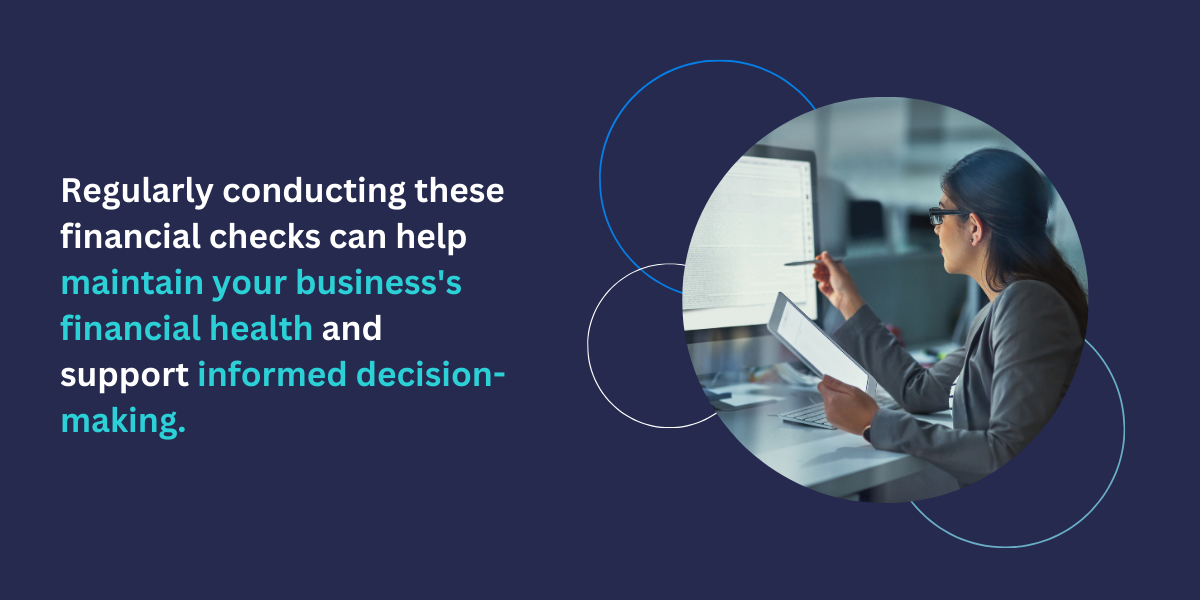Table of Contents - Quick Links
Ensuring the financial health of your business is crucial for sustained growth and stability. Regular financial assessments can help identify potential issues early and guide strategic decision-making. A strong financial foundation allows businesses to manage cash flow, navigate economic changes, and seize new opportunities without unnecessary risk. Detecting red flags in advance allows business owners to take proactive measures to prevent long-term financial issues. Here are five simple financial checks every business should perform:
1. Monitor Cash Flow
Regularly tracking your cash flow—the movement of money in and out of your business—is essential. Positive cash flow indicates that your business can meet its financial obligations, while negative cash flow may signal potential liquidity issues. Implementing cash flow forecasts can help anticipate future financial positions and inform budgeting decisions.
The quick ratio and cash flow margin are valuable financial metrics that help businesses monitor cash flow and ensure financial stability. her’s how each metric plays a role in cash flow management.
Quick Ratio (Liquidity Indicator)
- To calculate, subtract Inventory from Current Assets and divide by Current Liabilities: Current Assets – Inventory/Current Liabilities
- The quick ratio measures a company’s ability to meet short-term liabilities with its most liquid assets (cash, accounts receivable, marketable securities).
- A higher quick ratio (above 1.0) means the business has enough liquid assets to cover its short-term debts without relying on inventory sales.
- A low quick ratio (below 1.0) can indicate cash flow stress, meaning the company may struggle to pay upcoming expenses or debts without securing additional funding.
Cash Flow Margin (Profitability and Cash Flow Efficiency)
- Calculated by dividing Operating Cash Flow by Total Revenue and multiplying by 100: Operating Cash Flow/Total Revenue * 100
- The cash flow margin measures how efficiently a business converts revenue into actual cash flow from operations.
- A higher cash flow margin means the company is generating strong cash inflows relative to revenue, allowing it to reinvest, pay debts, and cover expenses.
- A low or negative cash flow margin signals that profits aren’t translating into cash, which could lead to cash flow shortages even if the business appears profitable on paper.
If the quick ratio is low but the cash flow margin is high, the business may have liquidity concerns but strong cash flow generation, indicating a need for better short-term cash management. If both metrics are low, it could signal serious cash flow issues that may require immediate action, such as adjusting payment terms, reducing expenses, or securing alternative financing like invoice factoring. If both are strong, the business has a healthy financial position with enough liquidity and operational cash flow to sustain growth.

2. Analyze Profit Margins for Financial Health
Understanding your profit margins helps determine the profitability of your products or services. Calculate both gross and net profit margins to assess how efficiently your business is generating profit relative to sales and overall financial health. Regular analysis can highlight areas where cost management or pricing strategies may need adjustment.
Gross Profit Margin (Profitability)
- This is a key financial metric that measures a company’s profitability by indicating the percentage of revenue that remains after subtracting the cost of goods sold (COGS). It shows how efficiently a business is producing and selling goods or services.
- Gross Profit Margin is calculated by subtracting COGS from Revenue, dividing by Revenue and then multiplying by 100: Revenue-COGS/Revenue) * 100
- A higher gross profit margin indicates that a company is keeping more of its revenue as profit after covering direct production costs.
- A lower margin suggests that production costs are high relative to revenue, which may indicate inefficiencies, pricing issues, or rising material/labor costs.
Net Profit Margin (Profit)
- A key financial metric that measures how much of a company’s total revenue is left as profit after all expenses are deducted. It reflects the overall profitability of a business and its ability to generate earnings after covering operating costs, taxes, interest, and other expenses.
- This calculation starts by dividing Net Profit by Total Revenue and multiplying by 100: (Net Profit/Total Revenue) * 100. Where Net Profit = Total Revenue – (COGS + Operating Expenses + Taxes + Interest + Other Expenses).
- A higher net profit margin indicates strong profitability and efficient cost management.
- A lower net profit margin suggests high expenses, pricing challenges, or operational inefficiencies.
3. Review Accounts Receivable and Payable
Keep a close eye on your accounts receivable (money owed to you) and accounts payable (money you owe). Ensure timely invoicing and follow-ups to maintain your financial health, and manage payables to avoid late fees and maintain good supplier relationships. Balancing these accounts effectively supports optimal cash flow management.
Tips to Manage Accounts Receivable for Financial Health
- Set Clear Payment Terms Upfront: Establish invoice due dates, penalties for late payments, and incentives for early payments.
- Automate Invoicing and Follow Ups: Use accounting software to send invoices immediately and automate reminders. Also, follow-up a few days before payment is due and immediately after a payment is late.
- Use Invoice Factoring for Faster Cash Flow: If you have long payment cycles or need cash on the day an invoice is issued, consider invoice factoring to convert unpaid invoices into immediate cash.
4. Assess Debt Levels
Evaluate your current debt obligations to ensure they are manageable within your business’s financial health. Monitoring debt-to-assets and interest coverage ratios can provide insights into your company’s financial leverage and ability to meet debt obligations.
Debt to Assets (Financial Stability)
- Calculated by dividing Total Debt by Total Assets: Total Debt/Total Assets
- Shows what percentage of a company’s assets are financed through debt.
- A higher ratio indicates more reliance on debt, which may pose financial risk.
- A lower ratio means the company uses more equity or retained earnings to finance assets.
5. Utilize Financial Health Tools
Leverage available resources to gain a comprehensive understanding of your business’s financial standing. For instance, Porter Capital offers a Business Health Check tool designed to assess various aspects of your company’s financial health. This tool can help identify strengths and areas for improvement, guiding strategic planning and financial management.
Regularly conducting these financial checks can help maintain your business’s financial health and support informed decision-making. By staying proactive, you can address potential issues before they escalate and position your business for long-term success.
Keeping Your Business Financially Healthy
Maintaining a healthy financial foundation requires regular check-ins and proactive management. Are you ensuring steady cash flow? Tracking your profit margins? Keeping debt levels in check?
Each of these financial checks plays a vital role in your business’s long-term stability. At Porter Capital, we help businesses stay on top of their financial health with tools like our Business Health Check. Take the next step toward financial clarity—call us today at 1-888-865-7678 or apply now to see how we can support your success.



